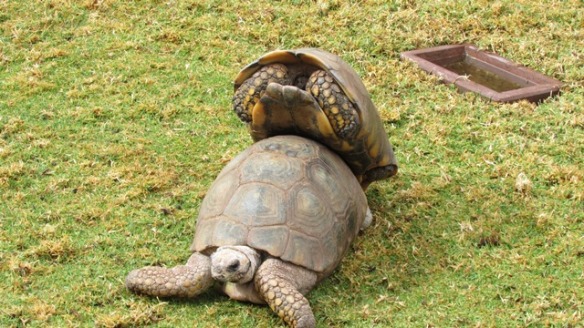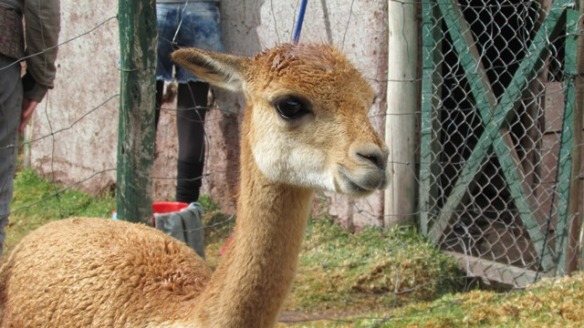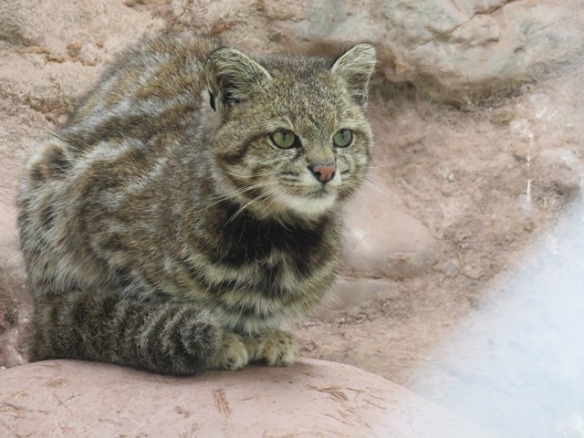Up early having packed the night before, this time we can only take one carry on bag and a back pack, as that is all that is allowed on the train the following day. We both made breakfast this time, the altitude sickness is on the wane, and we can face food again. For those of you who haven’t been over 9000′, it doesn’t affect everyone, and you can be fine one time and ill the next. For us, despite taking the Diamox, it meant headaches, lightheadedness, nausea, upset stomach, racing pulse and utter weariness. Thank goodness we are over it!
Minor hiccup when our second Fabricio came to collect us, we didn’t have the tickets for the trips to hand. A quick search failed to find them, so we set off anyway. Apologies for keeping them waiting to the other tour members we had met last night, and we were off on the bus.
The first stop was the Sacred Valley animal sanctuary, where my friend Wendy experienced the escaped anaconda. Fortunately they didn’t have one to care for at the moment (perhaps it escaped permanently!) but we did get to cuddle a friendly alpaca or two. We also met vicunas, who have the finest, most expensive wool, but are not so friendly, and like llamas, they spit at you. Yield from a vicuna is only 200gm of wool a year, as only the underbelly wool is used. We saw a wild Andean mountain cat, who was out for blood if you came anywhere near it we were told, a puma, guinea pigs, rabbits, and then we were seated for a display of flying by the condors. These huge birds are breathtaking, the Incas believed that they would carry your spirit up to the sky, and their feathers are much prized. Sadly now they are shot, as a single feather can make $500 on the black market.

Friendly alpacas


The male tortoise has a concave shell for obvious reasons!

Butter wouldn’t melt, look at those eyelashes, yet great spitters it seems!

Puma, mountain lion, they are the same thing

Likes to leap for your throat, not a cuddly pussycat this wild one

How’s that for a wing span? This one is male, you can tell by the white fluff at the back of the head. He is spreading his wings to sunbathe, the second a cloud arrived they were folded away. You can see how the Incas, who worshipped the Sun God Inti, revered these birds.
There was also a demonstration of hand weaving, it takes ten six hour days to make a scarf 1.5 metres in length. We have been warned that claims to sell ‘baby alpaca’ and often offering ‘may be alpaca’, ie largely synthetic. However the items in the shop were genuine, worked by hand, and 80% of the money raised going to the support of the sanctuary’s work in rescuing animals, and where possible releasing them back into the wild.
I bought a beautifully soft knitted scarf in a pale blue. We were also given a demonstration of natural dyes, mostly vegetable, but including the cochineal beetle,(those tiny white balls below)

which is actually white until crushed!
Pisaq
Next stop on the tour was Pisaq, perhaps best known for its Incan ruins, known as Inca Písac, which lie at the top of a hill at the entrance to the valley. The ruins are separated along the ridge into four groups: Pisaqa, Inti Watana, Qalla Q’asa, and Kinchiraqay. The Inti Watana group includes the Temple of the Sun, baths, altars, water fountains, a ceremonial platform, and an actual inti watana, a volcanic outcrop carved into a “hitching post for the Sun God Inti. The angles of its base suggest that it served to define the changes of the seasons. Qualla Q’asa is built onto a natural spur and overlooks the valley, and is known as the citadel.
The Inca constructed agricultural terraces on the steep hillside, which our guide told us are no longer used because of the risk of soil erosion. They created the terraces by hauling richer topsoil by hand from the lower lands. The terraces enabled the production of surplus food, more than would normally be possible at altitudes as high as 11,000 feet.
With military, religious, and agricultural structures, the site served at least a triple purpose. Researchers believe that Písaq defended the southern entrance to the Sacred Valley, with lookouts build high into the rock.
After Pisaq, it was time for lunch. We had been told to take snacks,and had come well prepared, but Fabricio said he had arranged lunch in a local restaurant for us all. Not going to miss that, so our packed lunch will have to become dinner! He takes us to a wonderful single story building with a large buffet set out, local dishes of beef casserole, what looked like chicken curry, marinated fish, salads, black potatoes, home baked bread, rice, tibboleh, and some mouthwatering little cheesecake squares and brownies (we we have to keep assisting the local cocoa trade!)

The bus set off again, and unsurprisingly I found it hard to stay awake, just jerking into life everytime Fabricio pointed out something interesting. We had heard about the pair of bulls on the top of each roof, to protect and bring good fortune the the family.

The cross is added just to make extra sure of the good fortune, in the way that the Peruvians have evolved their own inclusive catholicism
Now we learned about the sticks topped with red plastic bags fluttering from some houses. This means that the house has home brewed chicha beer available brewed from yellow corn. We were warned on no account to touch it, it would make us very ill! But it is consumed in large quantities at religious festivals. It is customary to pour a little on the ground first for the ‘Patchamama’ or Earth Mother.
The bus now draws up at the Ollantaytambo ruins, which are very crowded. There is a rehearsal going on (noisily) for a Solstice festival due to take place tomorrow in the arena, with lots of schoolchildren involved. Fabricio takes us away from the main site, and with the help of a book, explains the rock carvings. Including a king’s face a lot bigger than those of the Presidents in Mount Rushmore. It was built so that the sun at the solstice shines perfectly on the mayor’s house on the hill, and the crown of the King.

I hope you can make out his face, just above tree by the person with the red and white jacket and appears to be wearing a white crash helmet. It’s not too clear, but he has a crown on his head. The house to the left of the face, high up in the rock, was the Mayor’s house, he was the only one allowed to live up there. The larger building on the right, looking like a hotel, is actually the store for all the food they grew in the valley.
Inca entrances to anywhere important are super tall, and are recessed into a larger opening.

This one was the temple of the water, with running water channeled inside it.


This is an Incan calendar, accurate to the day, on the solstices the sun would hit the protrusions in the rock at the top and fall into the v shapes in the rock below (sadly some of these were destroyed by the Spaniards, who didn’t want any of this Incan ‘magic’)
A few more views of this site, the size of the people will give you an idea of size.
Back to the bus and off to the hotel, ours is actually on the station platform. Very handy for the morning, but I am a bit concerned about the ear plugs thoughtfully provided for each bed! There are three beds in this large room, the middle one is rock hard, so we will just have to wave at each other in the distance!












